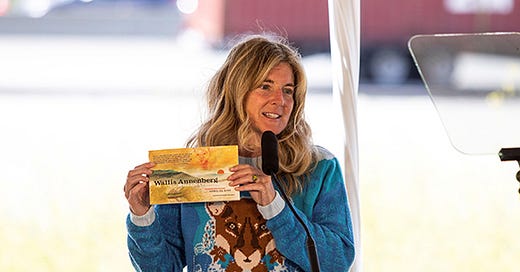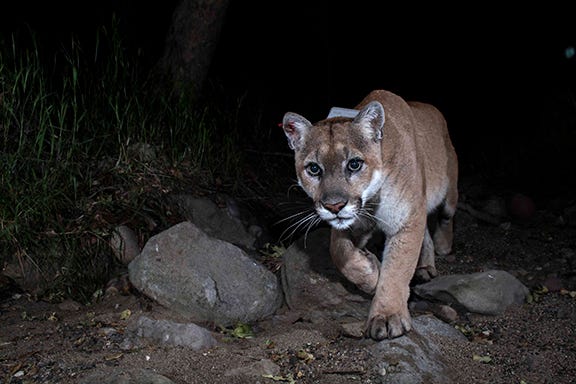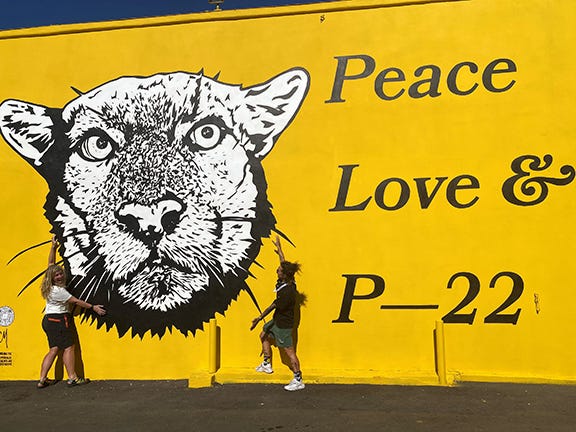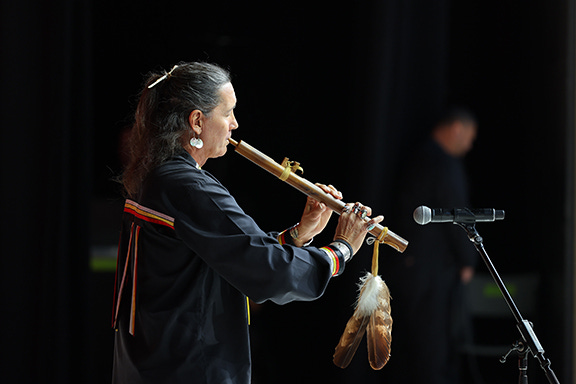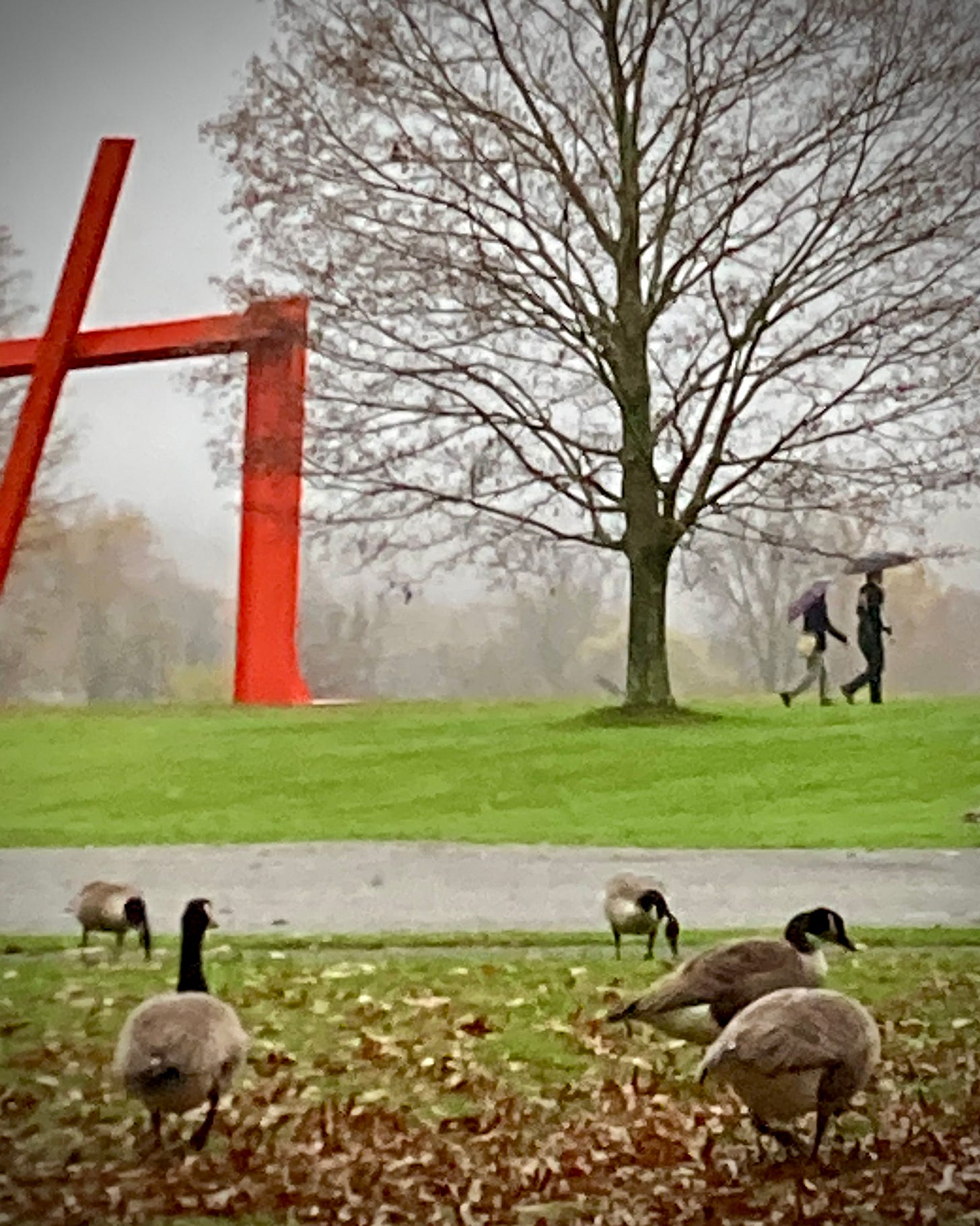When you picture wildlife in cities, what comes to mind? I think of raccoons, coyotes, songbirds, maybe a peregrine falcon. Also, the more problematic (though still fascinating!) rock doves, cockroaches, and Norwegian rats. All of these wild creatures—and many more—have found ways to use human-dominated ecosystems, with varying degrees of success.
I never would have considered the possibility that a mountain lion could exist in a city—until I learned about P-22, the big cat who spent a decade living in a park in Los Angeles.
As a champion for P-22 and other wild animals, Beth Pratt embraces creative outlets such as visual art and music to foster an emotional connection between the public and the animals around them. Thanks in large part to her efforts, support for the beloved P-22 has enabled the dream of creating a wildlife crossing over a busy Los Angeles freeway to become a reality.
Interview: Beth Pratt
How do you describe your work?
I joke that my job is making the scientists happy. Although I consider myself a scientist, it’s not my day job. My job as a conservation leader is to turn science into action—to ensure the solutions we need to give wildlife a future on this planet get implemented.
In my role as California Regional Executive Director for the National Wildlife Federation, I lead the #SaveLACougars campaign with many partners, which resulted in breaking ground on the visionary Wallis Annenberg Wildlife Crossing last year outside Los Angeles. It’s a landmark project that will help reconnect an ecosystem long fragmented by freeways and roadways for all wildlife, but more notably help save a population of mountain lions from extinction. And in helping to make it a reality, I made the National Park Service scientists who have studied the mountain lions and wildlife in the area for decades very happy—seeing their call to action from a scientific paper actually start being constructed is a great example of conservation in action.
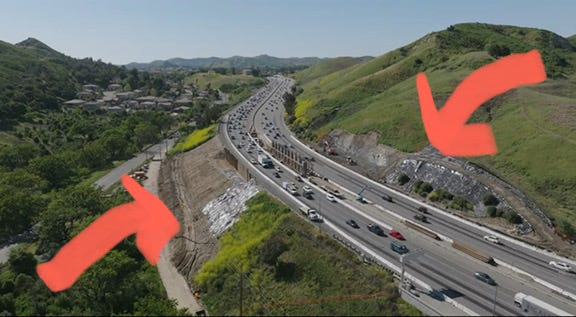
What aspect of your work has the most personal meaning for you?
The part of my work that has most personal meaning for me is how to shift the paradigm surrounding how people regard wildlife. Henry Beston wrote in his beautiful book, The Outermost House, "We need another and a wiser and perhaps a more mystical concept of animals… In a world older and more complete than ours they move finished and complete, gifted with extensions of the senses we have lost or never attained, living by voices we shall never hear. They are not brethren, they are not underlings; they are other nations, caught with ourselves in the net of life and time, fellow prisoners of the splendour and travail of the earth."
His profound words have always resonated with me since reading the book decades ago. In my work, I try to get people to see wildlife as beings, just as worthy of life as we are, as neighbors on this planet. The notion that animals are objects we can dominate has always been deeply troubling to me since I was a child.
How are science, art, and writing part of your work, and how is the interaction between these areas important to you?
Science is important. Science identifies problems and tells us how to solve them, and we need to lead with the science for solutions. But the science alone doesn’t ensure action. It’s the art, the stories, the inspiration, the capturing of the imagination that inspires people to act. Author Jon Mooallem made this point full force in his TED talk “The strange story of the teddy bear and what it reveals.” Mooallem says, “In a world of conservation reliance, those stories have very real consequences, because now, how we feel about an animal affects its survival more than anything that you read about in ecology textbooks. Storytelling matters now. Emotion matters. Our imagination has become an ecological force.”
My approach to work is to empower the artists to make that emotional connection. For P-22, the famous mountain lion who was the poster-cat for the Wallis Annenberg Wildlife Crossing, his plight inspired a movement around the world to build more crossings. And it was art that connected people to his plight in a way a scientific paper never could. This started with Steve Winter’s famous photograph published in National Geographic of the cat in front of the Hollywood sign. And then we had muralists capturing him on walls, musicians writing hip-hop songs for him, students performing plays in his honor—he was even honored with a musical composition, “Cool Cat,” performed at the Hollywood Bowl by Los Angeles Philharmonic Orchestra! All these artistic expressions from people is what enabled so many to connect to P-22 in different ways, and launched a conservation movement.
Is there a particular scientific/environmental problem that feels important to you? What do you do about that?
Connectivity. It’s pretty much become my life’s work. The day before P-22 died, I sat with him, grief stricken, and pledged I would never stop making the world safer for animals. We have not reckoned as a society with the moral cost of driving and roads, for both people and wildlife. These roads cause a devastating amount of death and suffering. Yet we tend to ignore it as we love our cars.
What I love about wildlife crossings is that for many environmental problems, there are no easy solutions, no magic answers. But for helping animals get across the road, the fix is pretty clear. These crossings are up to 97% successful where they are implemented. All that stands in the way is funding.
How does your perspective affect your work?
My moral compass is always directed toward what is in the best interest of wildlife. It’s their perspective I am interested in.
What influences and inspires you?
Wild animals inspire me with their resiliency. The challenges I face seem overwhelming at times, but then I see a butterfly with tattered wings fly over a windswept ridge at 10,000 feet, and I know if a tiny butterfly can persevere, so can I.
Another animal I study, the adorable but formidable pika, looks like a potato bunny and lives at high elevations in the Sierra. They don’t hibernate in the winter, but live under snow on the dried vegetation they gathered all summer. Not an easy existence, but they are a cheerful, Hobbit-like creature. I think humans should look more to the natural world not just for inspiration, but also for lessons in resiliency.
Do you have a formative experience from growing up that you feel was your 'spark' to lead to you where you are now? (question from Jenn Houle, 006)
I grew up north of Boston in a suburb called Garden City. I would play in the woods near my home along the Concord River, with frogs, turtles, squirrels, birds and other small creatures. One day a for sale sign went up in the woods, and I asked my mother what it meant. She told me they would be building homes there and cutting down the woods. I was devastated. It was the first time I realized how vulnerable wildlife was, that their homes could be taken away from them. I took a collection around the neighborhood, and raised about $5. I called the number on the real estate sign, and well, you can guess how this ended. But that experience at a young age turned me into a fierce advocate for wildlife.
Thank you, Beth!
Learn more about Beth and her work on her website, Facebook, or Twitter/X . You can also read her beautiful eulogy for P-22 here.
Branching Out
Rooted (Stuff I like, maybe slightly off topic.):
I recently visited Storm King, an outdoor sculpture park near New Windsor, New York. It’s a stunning example of art and nature intersecting and interacting in myriad ways. All three of the photos in this section are from our day there, and I could have shared a gazillion more images. It was beautiful even in the cold and rain!
Rounded (Preview of coming attractions.):
Environmental peacebuilding, an article by Peter Schwartzstein.
Also, if you’d like to dig more deeply into the subject of human interactions with wild animals, I recommend Creature Conserve’s Writing to Co-Exist with Animals Workshop.
Reaching (A question for you!):
In what ways do wildlife and wild places bring you peace?

